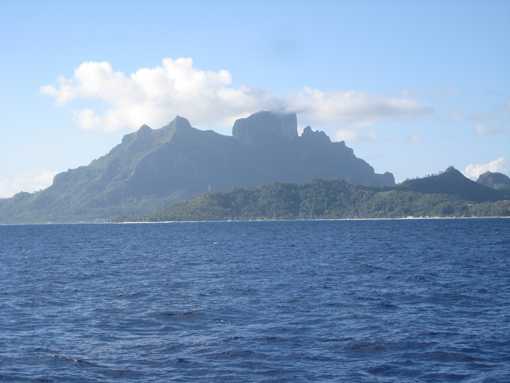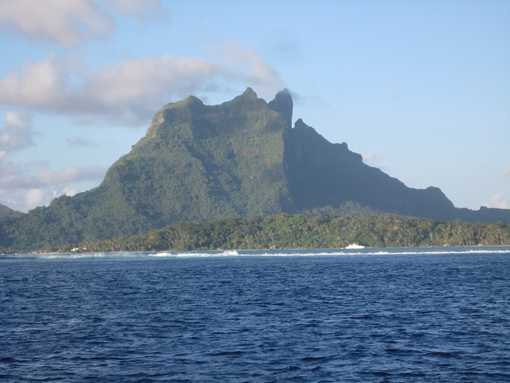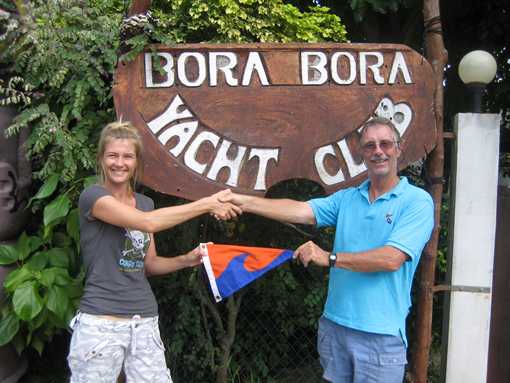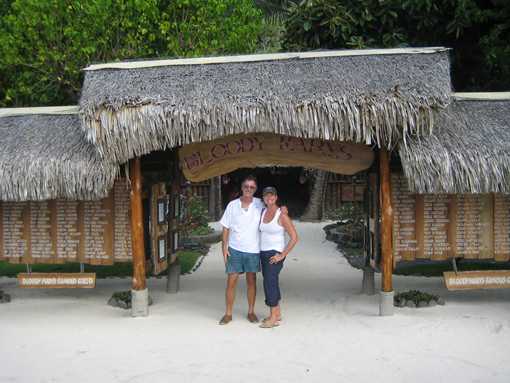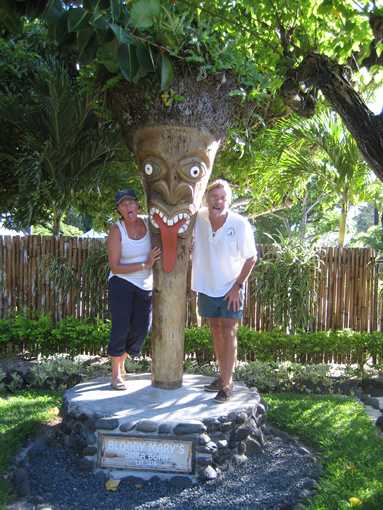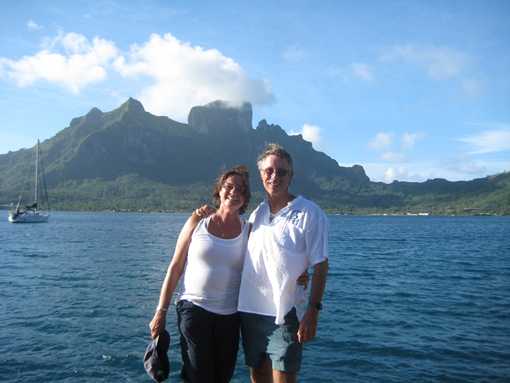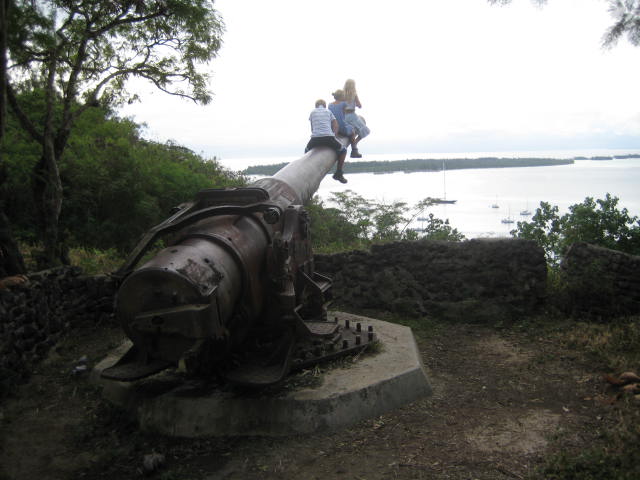Bora Bora, French Society Islands

Peregrina's Journey
Peter and Margie Benziger
Tue 11 Jan 2011 01:43
Position Report – 16:29.381S 151:45.627W
Bora Bora…Just the name evokes every exotic image of French
Polynesia imbedded in one’s mind from movies such as Mutiny on the Bounty, South
Pacific and even Brooke Shield’s practically “straight to video”
performance in Blue Lagoon. What’s more, five years ago, Peter had
joined a friend of ours who was participating in the 2005-2007 Blue Water Rally
for a month in the French Society Islands and he raved about Bora Bora
endlessly upon returning home. So I had
very high expectations.
I was not to be disappointed…
After a rather difficult journey from Tahaa to Bora Bora, we
finally arrived at the Bora Bora Yacht Club to the cheers of our fellow BWR-ers. It’s always a nice feeling to enter an
anchorage to round of applause!
Anyways, once we picked up a mooring ball and had a chance
to relax, we headed in to the Bora Bora Yacht Club with our own Coral Reef
Yacht Club burgee in hand and conducted an official introduction including the
presentation of our burgee to Jessica, the very sweet American married to a
French Polynesian named Teavi, who are the owners of the BBYC. See photo attached and note how cute she
is….which is no wonder why PETER is making the presentation of the burgee and
not me!
The Bora Bora Yacht Club suffered MAJOR damage from a
cyclone five months ago and Jessica and Teavi are working hard to rebuild it
despite the fact that they lost their home and all their possessions right next
door. They are living with their 3 year
old daughter in one small room right next to the bathrooms at the Yacht Club
while they wait for Bora Bora and the French government to give them some
public assistance. The French HEAVILY
subsidizes the economy here. Basically,
every man, woman and child gets a monthly stipend from France. The downside of this is that there is no real
incentive to work with the exception of the tourism industry and those involved
with imported goods. (And this appears to be mostly Chinese immigrants!)
When the cyclone
struck, no one had insurance so they just lined up to request assistance from
the Bora Bora/French government. I guess
that the Polynesians who lost their homes were aided first and now they are
starting to help the businesses and the ex-patriot community. I do hope that they provide some aid to the
Yacht Club as it is a beautiful facility and a really nice port of call for all
the sailors.
We rented electric bicycles with batteries and did a road
trip around the entire island with Carmen and Jaime from Bionic. I don’t think I will
ever want to ride a real bicycle again!
Those electric ones are so cool.
You pedal 2-3 times and then the little electric engine takes off with a
whoosh and you go about 200 feet without pedaling at all! And when you come to a hill, you just give it
a few extra strokes and up you go! We
did the entire island which had several big hills without breaking a
sweat!
It was very pretty and we stopped
at a couple of the luxury hotels, where they have all the over-the-water
bungalows, to look around. I have to say
tourism is way off here and it’s going to be really tough for all these mega
resorts to survive. It’s just like the
real estate industry. They seemed to
think that they could keep building these luxury accommodations which
apparently run between $1000-$3000 per night and the tourists (mostly
honeymooners who are a one-time shot) would keep them filled. As we’ve been sailing and touring around,
we’ve seen dozens and dozens of these romantic resorts and they all look
virtually empty. I’m guessing that you
could get a great deal on a vacation getaway if you could afford the
airfare! FYI - My favorite one was the
Bora Bora Nui Resort and Spa operated by Hilton on the little Motu of Toopua,
just a 15 minute ferry ride from Vaitape on the mainland of Bora Bora.
We made an obligatory stop at Bloody Mary’s Restaurant and
Bar while on our bicycle trip around the island and had a very nice lunch
although, once again, we were struck by how few patrons were enjoying this
well-known watering hole. Peter’s
recollection from five years ago was of crowds, day and night, and the photos
plastered along the entrance indicated that, in its heyday, Bloody Mary’s
attracted a fair share of Hollywood celebs but we saw just a couple other
tables filled with a “who’s who” of virtual unknowns!
A little history now…..The anchorage at the BBYC is in
Faanui Bay on the west side of the island.
Bora Bora was developed during WWII as an allied naval base and the U.S.
Seabees built the large wharf around the corner from Faanui Bay which was used
as a seaplane ramp. Across the lagoon is
Bora Bora’s international airport on Motu Mute, a flat island on the edge of
the barrier reef which the U.S. Marines built as a major refueling stop on
supply line between America and Australia.
From 1942-1946, Operation Bobcat transformed the island and, at its
peak, up to 6,000 soldiers were stationed here.
Tough job, but SOMEONE had to do it…..Leave it to the USA to set up an
outpost on an exotic French island with lots of bare-breasted women!
One afternoon, we took the “tiplets” from Miss Tippy (Annie, Charlotte and Freddy)
on a hike up a mountain above the anchorage to see two huge American cannons
that were installed there to protect the harbor from the Japanese. The kids are being “boat-schooled” for two
years and each one of them is working on a special project. Freddy’s is “Weapons” so we knew this would
be perfect for him and the girls are just up for anything and seem to really
enjoy spending time with us so off we went.
As you can imagine, Peter was just thrilled and he had them singing
marching songs and playing games and figuring out our position with his
hand-held compass. The cannons are
MASSIVE – they were built in 1908 and weigh almost 30,000 lbs - 15 tons! They were hauled up piece by piece and
re-assembled at the top of the mountain where they are strategically placed so
that they can shoot 10-12 miles out towards any boat that was approaching the
harbor.
We climbed all over them and took pictures of the kids and
explored all the nearby trenches and cement ruins from the battle
stations. On the way down, as it was
quite muddy along the trail, we covered our faces, arms and legs in mud as
camouflage and pretended we were soldiers.
When we got back to the yacht club, there was a whole bunch of people
there and in come marching this rag-tag group of “Green Berets” with mud all
over ourselves. We were quite a sight!
The next day, we took a trip to the southeast side of Bora
Bora along the inside of the lagoon in a “convoy” of five BWR yachts, Peregrina, Bionic, Simanderal, Jackamy and Blue Magic, who was in the lead. This was less than an enviable position as
the channel heading south was very narrow and filled with coral heads, also
known as “boomers”. I’ll let Peter
describe the way we picked our way through this maze…
"Navigating inside a
south Pacific atoll is always an adventure.
Relying exclusively on electronic charts is just NOT a good idea. In fact, more than once on this journey, the
electronic chart showed a navigational buoy in front of us when we had already
passed it! The best navigation is to
combine three sets of input data: 1)
what you see with your eyes 2) the depth sounder readings 3) the electronic
charts for general reference. The most
important input is definitely what you see with your eyes. With practice, you develop the ability to see
many colors of blue. Each shade has meaning including different depths. Light
blue indicates shallow water so the darker, the deeper. By looking down, you can also determine
what’s on the bottom – rock, grass or sand and, most importantly, you can pick
out the “boomers”!
The lagoon in Bora
Bora has many depths ranging from 100+ feet down to just a few inches. We were headed to the southeast corner via a
fairly well marked channel but there were still several tricky parts which
required use of all three navigational skills mentioned earlier. The depth in the channel was only 6-7 feet at
low tide so our caravan of relatively deep draft yachts went through at high
tide which adds about 2 feet. (Draft is
the measurement of the keel underwater)
Peregrina’s keel is 6.5 feet so, even at high tide, there was little
room for error. The most challenging part of the channel, near a reef called
Mahuoa Faao, has eight navigation markers with very little space between them
and all requiring specific turns either to starboard or port. It is very
important to stay in the middle of the channel even in tight spaces like
this. Blue Magic made it through
OK. Jackamy hit bottom once but
continued on without further problems.
Bionic was next but she took the first turn very wide and went into a
“garden of boomers” and was soon joined by Simanderal. Both stopped dead. Peregrina had already decided not to follow
these boats and rounded the mark inside them.
We made it through without incident.
Bionic and Simanderal were stuck for about a half hour as the tide was
dropping steadily but finally worked themselves clear with the help of their
bow thrusters. Bionic decided not to
continue and returned to the west side of Bora Bora. Simandral kept on but experienced some
problems with their steering which resulted from damage to the propeller. So you see that, even with a convoy of yachts
sailing basically the same course, the shallow waters of these Pacific atolls
can be very dangerous."
When we finally arrived, we anchored in about 12 feet of
water just off Motu Pitiaau. Peter
actually had to get into the water with a snorkel, fins and his hand held depth
meter and he swam a 120 foot circle around the boat measuring the coral heads
below us and making sure that, if the wind changed, we wouldn’t swing right
into one.
We went snorkeling the next day and saw tons of fish but, I
have to say that the tourists seemed to be killing the reef. There aren’t a lot of tourists here right now
– mostly honeymooners - but the ones we saw
are very negligent when it comes to walking all over the coral and they
bring bread to feed the fish - which really isn’t necessary. It makes the water all murky and I’m sure
isn’t good for the natural vegetation.
Plus, it makes the fish dependent on humans for their food source. You could tell they were much less
apprehensive around us and would come right up to our hands to see if we had
something for them to eat. I’m sure
those other people thought it was cool but it’s definitely not normal and you
could tell it was upsetting the balance of life.
Anyway, we did have a good snorkel despite all that and then
we went back to the boat and cleaned the hull as it had gotten all marked up
with black rubber from some tires that had been placed on a fueling dock that
we visited a couple days ago. There are
ALWAYS jobs to be done on Peregrina…
That night, the crews from Peregrina, Simanderal, Blue Magic and Jackamy all took our dinghies into a little “motu”- a tiny islet next to the reef - and had
dinner at a house right on the beach.
The owner is French Polynesian but he spent many years in California and
has dual citizenship with the USA. He
served in Vietnam and then got a degree in Nuclear-Physics from Stamford! With his degree he got a job back in the
Tuamotus working with the French government at their nuclear test bomb site but
soon became disillusioned and joined Green Peace. At some point, he went back to California and
imported Noni Juice to the United States
but, once Noni had its’ fifteen minutes of fame, the business collapsed
and he and his Mexican wife moved back to his family home on the Motu in Bora
Bora a few months ago. The family home
is a rambling collection of one story buildings. They have a portable electric
generator operating when people come to eat but otherwise use candles and go to
bed early. Life is very, very primitive here.
They opened up this little restaurant three weeks ago and the Blue Water
Rally boats were their first big group of patrons. Several boats had already eaten there and
told us about it so we brought a group of 11 and we really had a great
time. We had tuna sashimi with fresh lime
and a sauce that was to die for and then grilled tuna with another delicious
sauce. He catches the tuna that day and
the wife makes the sauces. We had white
rice and some really yummy cabbage. It
was a REAL bargain at $11 pp because the prices in Bora Bora are very high at
the restaurants. I hope they make it
successful as it appears that tourism is really off here and, in general, the
people are struggling to get by.
After dinner, we all got back into our dinghies and started
back to the boats but Blue Magic couldn’t find the “kill switch” for their
engine. A kill switch is a long red coil
that attaches with a clip to the engine.
It’s a safety feature because, when it is detached, the engine dies
immediately. Basically, you are supposed
to wear the kill switch around your wrist so that, if you fall off the boat, it
will pull the clip off, the engine will die and you won’t see your dinghy
driving off away from you in the middle of the ocean. But you can’t start the engine unless it is
clipped on so Blue Magic’s crew couldn’t move!
The others had already left so it was Peregrina to the Rescue! We towed them back to their boat with our
dinghy. The next morning, they went
back and found it lying in the shallow water right off the beach so all is well
and it was nice to be able to help.
We all headed back to the BBYC and the next day, we began
our journey to the Cook Islands….four nights and five days at sea before we
would arrive in Rarotonga.
